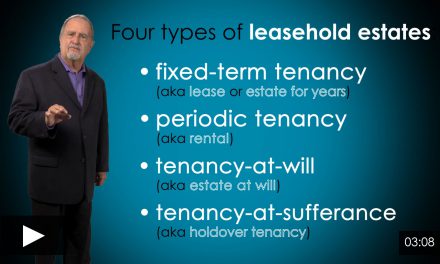This new video mini-series covers the mechanics of California real estate law, delving into the English and Spanish influence on California real estate, the authority of the California legislature to enact laws regulating real estate activities, and when federal and state law conflict.
The English and Spanish influence
Historically, California real estate law has been influenced by two key sources of human conduct:
- the English legal system, or common law; and
- the Spanish legal system, or civil law.
Related video:
The common law of England has been the predominant influence on California real estate law. This legal framework was officially adopted by California soon after obtaining statehood in 1850. [Calif. Civil Code §22.2]
Under the common law, legal disputes are decided on a case-by-case basis before a judge. Even today, the common law is often called “judge-made” law. When similar legal disputes arise, the judges refer back to the logic of earlier decisions to decide current cases. The reliance on an earlier decision to decide a current case is called stare decisis. The earlier case relied on is called precedent.
Similarly, the civil law of Spain had a significant impact on California real estate law. Civil law establishes statutes to settle legal disputes in advance, rather than on a case-by-case basis.
These legal traditions continue to exist today in the form of:
- statutes, regulations and ordinances; and
- case law.
The role of the U.S. Constitution
The United States Constitution (U.S. Constitution) is the supreme law of the United States. [United States Constitution, Article VI, clause 2]
All powers which the state and federal governments possess are derived from the U.S. Constitution.
The U.S. Constitution lists and explains the powers of the federal government. All other powers not given to the federal government rest with the individual states or with the people. [U.S. Const., Amend. X]
The form of government in which individual states share powers with a national or central government is called federalism.
Under federalism, the individual states remain independent (sovereign) to regulate any matters within their own borders which are not already controlled by the federal government.
Each state has its own constitution to regulate state matters remaining under their control. A state may provide more constitutional protection than the federal government when it chooses, but it may not provide less.
Separated powers
Both the federal and state governments created under the U.S. Constitution are separated into three branches:
- the legislative [U.S. Const., Art. I];
- the executive [U.S. Const., Art. II]; and
- the judicial. [U.S. Const., Art. III]
The state and federal legislatures enact the codes and statutes which regulate most aspects of real estate interests.
The executive polices the law and establishes regulations to carry out the administration of government as established by the legislature.
The judiciary settles disputes and issues case opinions regarding the application of the law and regulations.
No branch may exercise a power given to another branch.
American Rule
The Mexican-American War ended with the signing of the Treaty of Guadalupe Hidalgo. Under the treaty, the United States agreed to acknowledge the existing land grants conveyed by the Spanish and Mexican governments.
Related video:
The United States set up a land commission to document the validity of the land grants.
The land commission established land titles and created the chain of title
After confirmation of a valid land grant, the land was surveyed by the federal government and conveyed to the rightful owner by a United States patent deed.
All land not under a valid claim became part of the public domain of the United States.
In 1850, the United States granted part of the unclaimed real estate to the State of California. The balance was retained by the federal government.
The federal and state legislatures as well as local governments enact laws they have been authorized to by the United States Constitution or the California Constitution.
Authority to legislate
The authority of the California legislature to enact laws regulating real estate activities comes from four main constitutional powers.
Related video:
These four constitutional powers are:
- police power;
- power of eminent domain;
- power to tax; and
- escheat, the reverting of property to the state when the owner dies and there are no capable heirs to inherit it.
These four powers can be memorized using the mnemonic device PETE.
The U.S. Constitution confers on California the right to enact laws to protect public health, safety and welfare. [U.S. Const., Amend. X]
The California Constitution confers an equal power to local cities and counties to likewise protect the public good. [California Constitution, Article XI §7]
This power to protect the public well-being is called police power
Police power is the basis for laws governing such things as highway construction and maintenance, rent control, zoning and traffic. [Village of Euclid, Ohio v. Ambler Realty Co. (1926) 272 US 365]
A statute or ordinance passed under the government’s constitutional police power and affecting real estate-related activity is valid as long as the law:
- is fair and reasonable;
- addresses a legitimate state interest;
- does not unreasonably burden the flow of interstate commerce; and
- does not conflict with related federal law.
Eminent domain
The second key power of the state to regulate real estate is the power of eminent domain
Related video:
Eminent domain is the right of the government to take private property for public use. The process of using the power of eminent domain is called condemnation.
However, the government needs to pay the owner the fair market value of the property taken. [Loretto v. Teleprompter Manhattan CATV Corp. (1982) 458 US 419]
Examples of eminent domain include condemning property to provide highways and roads, establish parks, construct flood control levees and provide land for redevelopment.
Inverse condemnation
The government’s exercise of police power may become a taking of an owner’s real estate by inverse condemnation when the government surpasses their power of eminent domain.
For example, an owner demolishes their beachfront bungalow. The owner intends to rebuild a better home and submits an application to the coastal commission which has jurisdiction over the use of beachfront property.
A public beach is located nearby, but not directly adjacent to the owner’s real estate.
The coastal commission grants the owner a permit to build, conditioned on the owner granting to the public a frontage easement across their beachfront property. The coastal commission claims its goal is to allow better public viewing of the coastline.
The owner refuses to comply with the condition unless the coastal commission pays for the easement. The coastal commission denies the owner’s application and permit to build, claiming it is reasonably exercising its police power.
Does the coastal commission have to pay for the easement across the owner’s beachfront?
Yes! The coastal commission has not merely restricted the owner’s use of their land, it has required the owner to deed an interest away in the form of a frontage easement. [Nollan v. California Coastal Commission (1987) 483 US 825]
Conditioning a permit to build on the granting of an easement to the public is a taking which requires reimbursement to the owner from the governmental agency. The coastal commission did not show the easement related to a legitimate state interest to constitute eminent domain. Instead, the government agency’s action — in this case, demanding an easement as a condition of administratively granting a permit — leads to the taking of real estate and is inverse condemnation.
However, most California inverse condemnation cases filed by owners fail. California courts do not want to burden local governments with the obligation of paying for any diminution of property values which result each time it regulates or downgrades the use of real estate. [First English Evangelical Lutheran Church of Glendale v. County of Los Angeles (1989) 210 CA3d 1353]
The power to tax
State and local governments also regulate the crucial power to tax real estate activities to generate revenue and fund state and local governmental functions under their police power. [Calif. Const., Art. XIII D §6]
For example, a city passes an ordinance which imposes an inspection fee on all landlords renting residential properties. The fee charged is based on a flat rate per unit, not on current property values.
A landlord subject to the ordinance claims the ordinance is unenforceable since the city must have voter approval before adopting an ordinance which imposes a regulatory fee on property.
The city claims the ordinance is enforceable without voter approval since the fee is imposed on a use of the property — renting — not on the mere ownership of the property, which requires voter approval.
Here, the ordinance imposing the inspection fee on landlords based on a flat rate per unit offered for rent is enforceable. Voter approval is only required when fees and taxes are imposed on owners simply because they own real estate. Fees and taxes imposed on the owner’s exercise of his uses and rights which come with owning the property do not require voter approval. [Apartment Association of Los Angeles v. City of Los Angeles (2001) 24 C4th 830]
The power of escheat
The last constitutional power is escheat
Escheat occurs when the owner of a property dies, and they have no heirs to inherit it. When this occurs, ownership of the property reverts automatically to the state.
Escheat also refers to the process of transferring abandoned property to the state, whether or not the rightful owner is still alive.
For example, banks possessing an individual’s property (read: money) have a duty to return the property to the owner after three years of inactivity. [California Code of Civil Procedure §1513(a)(a)(A)]
Intangible personal property escheats to the state when:
- the last known address of the apparent owner is in California;
- no address of the apparent owner appears on the records of the holder and:
- the last known address of the apparent owner is in California; or
- the holder resides in California and has not previously paid the property to the state of the last known address of the apparent owner; or
- the holder is part of California’s government and has not previously paid the property to the state of the last known address of the apparent owner;
- the last known address of the apparent owner is in a state that does not provide by law for the escheat of such property and the holder is:
- domiciled in this state; or
- a government or governmental subdivision or agency of this state; or
- the last known address of the apparent owner is in a foreign nation and the holder is:
- domiciled in this state; or
- a government or governmental subdivision or agency of this state. [CCP §1510]
Holders of unclaimed property have a duty to notify owners of unclaimed property valued over $50 before reporting it to the state. [CCP §1520(b)]
One can access the public interface on the website of the State Controller’s office to determine whether the state holds any unclaimed property that has been escheated to the state after a period of inactivity.
Just as one regularly checks their credit score, brokers and other small business owners ought to make it a habit to periodically determine whether they have any unclaimed property with the state so they may get it back.
When federal and state law conflict
The federal government’s authority to regulate real estate also comes from the U.S. Constitution.
Like the state, the federal government has the power to tax and the power to take private property for public use. [U.S. Const., Amend. XVI; Calif. Const., Art. 1 §19]
Related video:
However, the federal government has no police power. In its place, the federal government has a powerful clause to regulate areas of national concern, called the commerce clause.
The federal government has the right to regulate all commercial enterprises which affect interstate commerce.
Originally, the clause was designed to combat attempts by local states to pass protectionist laws under their police powers which would inhibit the flow of goods between states — interstate commerce. [Gibbons v. Ogden (1824) 22 US 1]
Today, the clause also applies to local and intrastate activities which have an indirect effect on the flow of goods, services and people from state to state.
For example, the federal government’s interest in the flow of commerce between states outweighs a motel owner’s right to exclude specific classes of patrons. The owner’s exclusion interferes with the flow of commerce – which includes the mobility of people. [Heart of Atlanta Motel, Inc. v. United States (1964) 379 US 241]
The federal government’s ability to regulate a purely local activity even extends to local real estate brokers’ activities within their trade unions.
For example, a broker sues the local board of realtors for federal antitrust violations, claiming the association fixes rates charged by its members for their services.
The association ostracizes brokers who refuse to comply with the fee-setting policies established by the association based on the maintenance of a minimum acceptable level of income for its union members.
The association claims the federal government may not regulate their activities as their services are purely local and have no effect on interstate commerce.
Do the federal antitrust laws cover local brokerage activities?
Yes! The association’s fee-setting of the charges for their members’ services affects housing locally, which in turn affects the desire to live in the area, which in turn affects the mobility of people in interstate commerce. [McLain v. Real Estate Board of New Orleans, Inc. (1980) 444 US 232]
Alternatively, states have the sovereignty to regulate within their own borders. At the same time, the federal government has the right to regulate local activities affecting commerce.
What happens when federal and state law conflict? Consider the following example.
An airport is established under the Federal Aviation Act of 1953. The airport expands its number of late-night and early-morning flights. The residents around the airport complain of the noise during late and early hours.
The city where the airport is located passes an ordinance restricting the number of flights between 11 p.m. and 7 a.m.
The airport objects, claiming it was established under the sole jurisdiction of federal law and the Federal Aviation Act of 1953 set forth by the Federal Aviation Administration (FAA) which has no restriction on flights between 11 p.m. and 7 a.m.
Does the federal law preempt (supersede) state law?
Yes! The goals of national flight service and the role of the FAA outweigh local laws inhibiting flight times. [City of Burbank v. Lockheed Air Terminal, Inc. (1973) 411 US 624]
A federal law will preempt state and local statutes and ordinances when:
- federal interests outweigh local interests;
- the federal law is so pervasive as to exclude inconsistent state law; and
- inconsistent treatment nationwide would result if state law controls.
Thus, it is possible for federal and state law to regulate the same real estate activity.
For example, federal and state fair housing laws prohibiting discrimination exist. Both the state and federal governments can regulate fair housing. The state may provide more, but may not allow less, protection than the federal law. [Calif. Civil Code §51]














